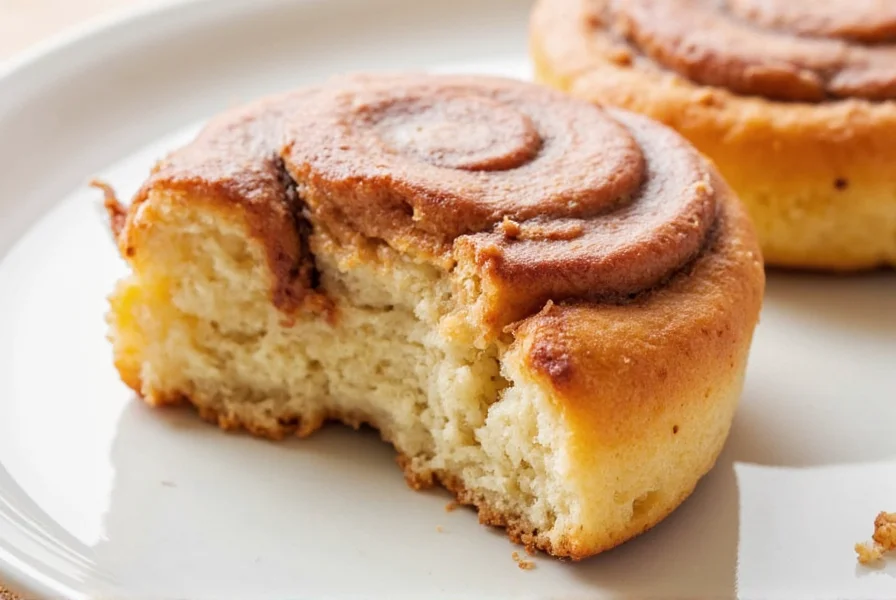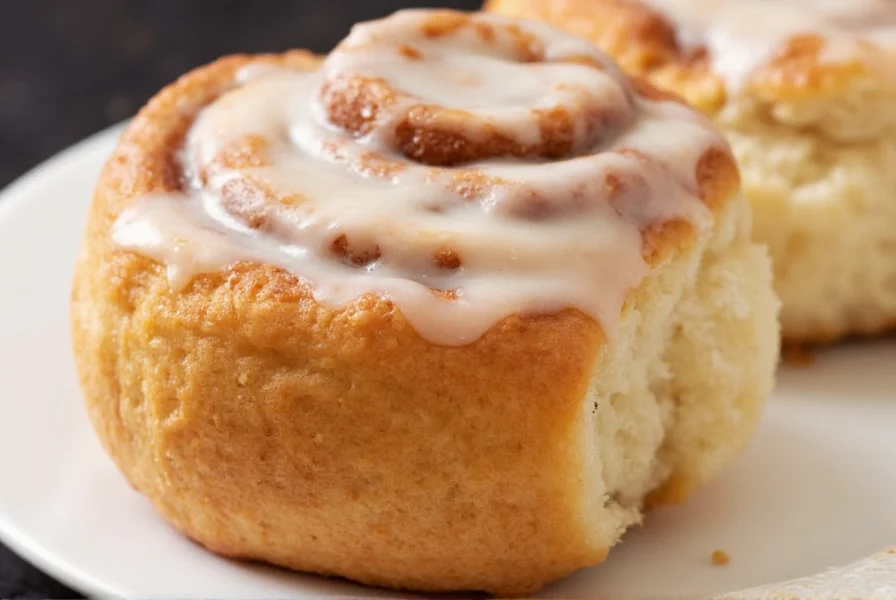Here's the simplest way to make perfect cinnamon rolls: Combine 2¼ tsp active dry yeast, 1 cup warm milk, ⅓ cup sugar, 1 egg, ¼ cup melted butter, 3½ cups flour, and 1 tsp salt to make the dough. Let it rise for 1 hour. Roll out, spread with ½ cup softened butter, 1 cup brown sugar, and 3 tbsp cinnamon. Roll, slice, and bake at 350°F for 20-25 minutes. Frost with cream cheese icing.
Nothing beats the aroma of freshly baked cinnamon rolls on a weekend morning. This easy homemade cinnamon roll recipe delivers soft, fluffy results every time without complicated techniques or specialty ingredients. After testing dozens of variations over 15 years of baking, I've perfected a method that eliminates common pitfalls while keeping preparation straightforward for home bakers of all skill levels.
Unlike many recipes that require overnight proofing or multiple rises, this version works reliably in just 2 hours from start to finish. The secret lies in precise ingredient ratios and clear visual cues at each stage—no guesswork required. Whether you're making cinnamon rolls for beginners or need a last-minute breakfast solution, this approach guarantees bakery-quality results.
Why This Easy Cinnamon Roll Recipe Works
This method solves three common problems with traditional recipes:
- Yeast anxiety—Using the right milk temperature (105-115°F) ensures perfect activation without killing the yeast
- Dense rolls—The precise butter-to-flour ratio creates tender layers without gumminess
- Burnt bottoms—Baking on the middle rack with aluminum foil prevents over-browning
| Prep Time | Rise Time | Bake Time | Total Time | Servings |
|---|---|---|---|---|
| 25 minutes | 60 minutes | 22 minutes | 1 hour 47 minutes | 12 rolls |
Ingredients for Foolproof Cinnamon Rolls
Use standard grocery store ingredients—no specialty items required. All measurements are precise for consistent results.

Dough
- 2¼ teaspoons (1 packet) active dry yeast
- 1 cup whole milk, warmed to 105-115°F
- ⅓ cup granulated sugar
- 1 large egg, room temperature
- ¼ cup unsalted butter, melted
- 3½ cups all-purpose flour (spooned and leveled)
- 1 teaspoon salt
Filling
- ½ cup unsalted butter, softened to room temperature
- 1 cup packed light brown sugar
- 3 tablespoons ground cinnamon
- ¼ teaspoon salt
Cream Cheese Frosting
- 4 ounces cream cheese, softened
- ¼ cup unsalted butter, softened
- 1 cup powdered sugar
- ½ teaspoon vanilla extract
- 1-2 tablespoons milk
Step-by-Step Instructions for Easy Cinnamon Rolls
- Activate the yeast: In a large bowl, combine warm milk, sugar, and yeast. Wait 5-7 minutes until foamy. If no bubbles form, start over with new yeast.
- Mix dough: Whisk in egg and melted butter. Gradually add flour and salt until a shaggy dough forms.
- Knead: Turn onto floured surface and knead 5-7 minutes until smooth and elastic. Dough should spring back when poked.
- First rise: Place in greased bowl, cover with damp cloth, and let rise in warm spot for 60 minutes or until doubled.
- Prepare filling: While dough rises, mix brown sugar, cinnamon, and salt. Soften butter until spreadable but not melted.
- Roll and fill: Punch down dough and roll into 16x12 inch rectangle. Spread softened butter evenly, then sprinkle filling mixture.
- Shape: Roll tightly from long side, pinch seam closed. Cut into 12 equal slices using dental floss for clean cuts.
- Bake: Place in greased 9x13 inch pan, cover, and rise 30 minutes. Bake at 350°F for 20-25 minutes until golden.
- Frost: Mix frosting ingredients until smooth. Spread on warm rolls.
Pro Tips for Perfect Cinnamon Rolls Every Time
These essential cinnamon roll baking tips address the most common failures:
- Milk temperature matters: Use a thermometer—too hot kills yeast, too cold won't activate it
- Flour measurement: Spoon flour into measuring cup then level—don't scoop directly
- Rise environment: Place dough in oven with light on for consistent 80-85°F temperature
- Cutting technique: Use unflavored dental floss instead of knife to prevent squishing
- Baking test: Rolls are done when internal temperature reaches 190°F
Troubleshooting Common Issues
Fix these problems before they happen:
| Problem | Why It Happens | Solution |
|---|---|---|
| Dense rolls | Too much flour or killed yeast | Measure flour correctly; test yeast in warm liquid first |
| Filling leaks out | Dough too cold or filling too thick | Let dough rest 5 minutes before rolling; use even butter layer |
| Burnt bottoms | Oven too hot or pan too dark | Use light-colored pan; tent with foil after 15 minutes |
Delicious Variations for Your Easy Cinnamon Roll Recipe
Customize this basic cinnamon roll recipe with these tested options:
- Apple Cinnamon Rolls: Add 1 cup finely diced apples to filling
- Cheesecake Swirl: Mix 4 oz cream cheese into filling
- Gluten-Free Version: Substitute 1:1 gluten-free flour blend (add 1 tsp xanthan gum)
- Vegan Option: Use plant-based butter, almond milk, and flax egg
Storing and Reheating Instructions
Enjoy fresh cinnamon rolls anytime:
- Room temperature: Store in airtight container for up to 2 days
- Refrigerator: Keep for 5 days—reheat 10 seconds in microwave
- Freezer: Wrap individual rolls in plastic, then foil. Freeze up to 3 months. Thaw at room temperature 2 hours before reheating.
- Best reheating method: 15 seconds in microwave covered with damp paper towel
This easy cinnamon roll recipe from scratch proves that homemade doesn't have to mean complicated. By focusing on precise measurements, clear visual cues, and addressing common pain points, you'll create bakery-quality results that impress every time. The secret isn't special ingredients—it's understanding the why behind each step. Now that you've mastered this foundational recipe, feel confident experimenting with your own variations while maintaining perfect texture and flavor.
Can I make this easy cinnamon roll recipe without a stand mixer?
Yes, this recipe works perfectly with hand mixing. After combining ingredients in a bowl, turn the shaggy dough onto a floured surface and knead by hand for 5-7 minutes until smooth and elastic. The key is developing the gluten through manual kneading rather than relying on a machine.
Why did my cinnamon rolls come out dense?
Dense rolls typically result from too much flour or dead yeast. Measure flour by spooning into the cup then leveling—don't scoop directly from the bag. Always test yeast in warm liquid first; it should become foamy within 5-7 minutes. Cold kitchen temperatures can also slow rising—find a warm spot (75-80°F) for your dough to rise properly.
How do I prevent the filling from leaking out during baking?
To keep filling contained, ensure your dough is at room temperature before rolling (cold dough cracks). Spread a thin, even layer of softened butter first, then sprinkle filling mixture. Roll tightly but gently, and use dental floss instead of a knife to cut slices. Place rolls with the cut side down in the pan to seal the filling inside during baking.
Can I prepare these cinnamon rolls the night before?
Yes, for next-morning baking: After cutting rolls, place in greased pan, cover tightly, and refrigerate overnight. Next morning, remove from fridge 30 minutes before baking to take the chill off, then bake as directed. The cold rise develops deeper flavor while maintaining perfect texture.
What's the best way to reheat cinnamon rolls without drying them out?
For best results, wrap individual rolls in a damp paper towel and microwave for 10-15 seconds. The moisture prevents drying while gently warming the roll. Alternatively, place on a baking sheet and warm in a 300°F oven for 5-7 minutes. Never reheat at high temperatures, which cause rapid moisture loss and tough texture.
Frequently Asked Questions
Can I make this easy cinnamon roll recipe without a stand mixer?
Yes, this recipe works perfectly with hand mixing. After combining ingredients in a bowl, turn the shaggy dough onto a floured surface and knead by hand for 5-7 minutes until smooth and elastic. The key is developing the gluten through manual kneading rather than relying on a machine.
Why did my cinnamon rolls come out dense?
Dense rolls typically result from too much flour or dead yeast. Measure flour by spooning into the cup then leveling—don't scoop directly from the bag. Always test yeast in warm liquid first; it should become foamy within 5-7 minutes. Cold kitchen temperatures can also slow rising—find a warm spot (75-80°F) for your dough to rise properly.
How do I prevent the filling from leaking out during baking?
To keep filling contained, ensure your dough is at room temperature before rolling (cold dough cracks). Spread a thin, even layer of softened butter first, then sprinkle filling mixture. Roll tightly but gently, and use dental floss instead of a knife to cut slices. Place rolls with the cut side down in the pan to seal the filling inside during baking.
Can I prepare these cinnamon rolls the night before?
Yes, for next-morning baking: After cutting rolls, place in greased pan, cover tightly, and refrigerate overnight. Next morning, remove from fridge 30 minutes before baking to take the chill off, then bake as directed. The cold rise develops deeper flavor while maintaining perfect texture.
What's the best way to reheat cinnamon rolls without drying them out?
For best results, wrap individual rolls in a damp paper towel and microwave for 10-15 seconds. The moisture prevents drying while gently warming the roll. Alternatively, place on a baking sheet and warm in a 300°F oven for 5-7 minutes. Never reheat at high temperatures, which cause rapid moisture loss and tough texture.











 浙公网安备
33010002000092号
浙公网安备
33010002000092号 浙B2-20120091-4
浙B2-20120091-4